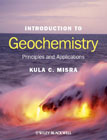
This book is intended to serve as a text for an introductory course in geochemistry for undergraduate/graduate students with at least an elementarylevel background in earth sciences, chemistry, and mathematics. The text, containing 83 tables and 181 figures, covers a wide variety of topics ranging from atomicstructure to chemical and isotopic equilibria to modern biogeochemical cycleswhich are divided into four interrelated parts: Crystal Chemistry; Chemical Reactions (and biochemical reactions involving bacteria); Isotope Geochemistry (radiogenic and stable isotopes); and The Earth Supersystem, which includes discussions pertinent to the evolution of the solid Earth, the atmosphere, and the hydrosphere. In keeping with the modern trend in the field of geochemistry,the book emphasizes computational techniques by developing appropriate mathematical relations, solving a variety of problems to illustrate application of the mathematical relations, and leaving a set of questions at the end of each chapter to be solved by students. However, so as not to interrupt the flow of the text, involved chemical concepts and mathematical derivations are separated in the form of boxes. Supplementary materials are packaged into ten appendixes that include a standardstate (298.15 K, 1 bar) thermodynamic data table and a listing of answers to selected chapterend questions. INDICE: Preface. Acknowledgments. Chapter 1. Introduction. 1.1 Units of measurement. 1.2 The Geologic Time Scale. 1.3 Recapitulation. 1.4 Questions. PART I CRYSTAL CHEMISTRY. Chapter 2. Atomic Structure. 2.1 Historical development. 2.2 The working model. 2.3 The ground state electronic configuration of elements. 2.4 Chemical behavior of elements. 2.5 Summary. 2.6 Recapitulation. 2.7 Questions. Chapter 3. Chemical Bonding. 3.1 Ionic bonding. 3.2 Crystal structures of silicate minerals. 3.3 Ionic substitution in crystals. 3.4 Crystalfieldtheory. 3.5 Isomorphism, polymorphism, and solid solutions. 3.6 Covalent bonding. 3.7 Metallic bonds. 3.8 Van der Waals bonds. 3.9 Hydrogen bond. 3.10 Comparison of bond types. 3.11 Goldschmidt's classification of elements. 3.12 Summary. 3.13 Recapitulation. 3.14 Questions. PART II CHEMICAL REACTIONS. Chapter 4. Basic Thermodynamic Concepts. 4.1 Chemical equilibrium. 4.2 Thermodynamic systems. 4.3 Laws of thermodynamics. 4.4 Auxiliary thermodynamic functions. 4.5Free energy change of a reaction at T and P. 4.6 Conditions for thermodynamicequilibrium and spontaneity in a closed system. 4.7 Metastability. 4.8 Computation of simple PT phase diagrams. 4.9 Thermodynamic data tables. 4.10 Summary. 4.11 Recapitulation. 4.12 Questions. Chapter 5. Thermodynamics of Solutions.5.1 Chemical potential. 5.2 Variation of chemical potential ( ) with temperature, pressure, and composition. 5.3 Relation between Gibbs free energy change and equilibrium constant for a reaction. 5.4 Gases. 5.5 Ideal solutions involving condensed phases. 5.6 Nonideal solutions involving condensed phases. 5.7 Excess functions. 5.8 Ideal crystalline solutions. 5.9 Nonideal crystalline solutions. 5.10 Summary. 5.11 Recapitulation. 5.12 Questions. Chapter 6. Geothermometry and Geobarometry. 6.1 Tools for geothermobarometry. 6.2 Selection of reactions for thermobarometry. 6.3 Dependence of equilibrium constant on temperature and pressure. 6.4 Univariant reactions and displaced equilibria. 6.5 Exchange reactions. 6.6 Solvus equilibria. 6.7 Uncertainties in thermobarometric estimates. 6.8 Fluid inclusion thermobarometry. 6.9 Summary. 6.10 Recapitulation. 6.11 Questions. Chapter 7. Reactions Involving Aqueous Solutions. 7.1 Water's a solvent. 7.2 Activity concentration relationships in aqueous electrolyticsolutions. 7.3 Dissociation of acids and bases. 7.4 Solubility of salts. 7.5 Dissociation of H2CO3 acid the carbonic acid system. 7.6 Acidity and alkalinity of a solution. 7.7 pH buffers. 7.8 Dissolution and precipitation of calcium carbonate. 7.9 Chemical weathering of silicate minerals. 7.10 Summary. 7.11 Recapitulation. 7.12 Questions. Chapter 8. Oxidation-Reduction Reactions. 8.1 Definitions. 8.2 Voltaic cells. 8.3 Relationship between free energy change (DGr) and electrode potential (
- ISBN: 978-1-4051-2142-2
- Editorial: Wiley-Blackwell
- Encuadernacion: Rústica
- Páginas: 640
- Fecha Publicación: 11/11/2011
- Nº Volúmenes: 1
- Idioma: Inglés
